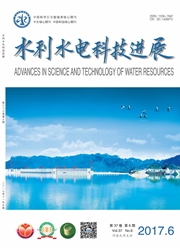

 中文摘要:
中文摘要:
为分析我国水资源利用效率和节水潜力,以海河流域为参照地区,基于1999 年、2002 年和2007 年全国和海河流域水利投入占用产出表,通过比较全国和海河流域分部门的用水效率,建立了分部门节水潜力的计算模型,并应用该模型计算了全国相对海河流域生产部门中分三次产业和分51 部门及消费部门中居民部门的节水潜力.计算结果表明:全国相对海河流域的总节水潜力在1999-2007 年期间不断扩大;全国第一产业和第二产业中的工业部门相对海河流域的节水潜力较大,第二产业中的建筑业和第三产业相对海河流域的节水潜力较小;全国居民部门相对海河流域的节水潜力主要体现在农村居民部门,城镇居民部门相对海河流域的节水潜力为负.从细分的51 部门来看,除农业部门以外,全国相对海河流域节水潜力较大的部门主要有电力及蒸汽热水生产和供应业(不含水电)、化学工业、金属冶炼及压延加工业、造纸印刷及文教用品制造业、食品制造及烟草加工业等.
 英文摘要:
英文摘要:
To analyze water use efficiency and water saving potential in China, based on the water conservancy input-occupancy-output tables of China and Haihe River basin in 1999, 2002 and 2007, we proposed a model to calculate water saving potential by sector compared with Haihe River basin, and a model to calculated the water conservation potential by sector. We applied the model in China compared with Haihe River basin and we found that the total water conservation potential of the national economy, compared with Haihe River basin, expanded from 1999 to 2007. Water conservation potential in the primary industry and the secondary industry was relatively large while water conservation potential in the tertiary industry and construction industry was small. In comparison with urban residents, rural residents showed more water conservation potential. Besides the agricultural sector, sectors, such as electricity, steam, hot water production and supply industry( without water electricity) , chemical industry, metal smelting and rolling processing industry, paper printing and stationery manufacturing industry, food production and tobacco processing industry, among others, also showed great water conservation potential.
 同期刊论文项目
同期刊论文项目
 同项目期刊论文
同项目期刊论文
 By Sector Water Consumption and Related Economy Analysis Integrated Model and Its Application in Hai
By Sector Water Consumption and Related Economy Analysis Integrated Model and Its Application in Hai A grey neural network and input-output combined forecasting model and its application in primary ene
A grey neural network and input-output combined forecasting model and its application in primary ene A Multi-Factor Decomposing Model and Its Application in Finding Impacting Factors of Beijing Water U
A Multi-Factor Decomposing Model and Its Application in Finding Impacting Factors of Beijing Water U Finding Underlying Changes among sectors for the structure transformation of an economy with Hierarc
Finding Underlying Changes among sectors for the structure transformation of an economy with Hierarc 期刊信息
期刊信息
